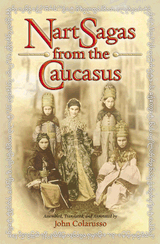Wonders and Marvels introduces a collection I had not heard of before
Nart Sagas:
Ancient Myths and Legends of the Circassians and Abkhazians. It comes out in paperback in the first half of 2016. I bet you can find a hardbound copy through the expertise of your local librarian.
A Nart saga from Abkhazia (NW Caucasus) credits a folk hero, Sasruquo, with the discovery of a unique method of taming a headstrong horse. In the tale, Sasruquo needs to travel quickly to an important assembly of many tribes. This was in the time when only the Narts knew the secrets of domesticating wild horses. But after his beloved horse Bzow died, Sasruquo had vowed to “sit astride no other steed.”
He sets off on foot but must cross a furiously churning river. He notices a wild stallion grazing on the bank. Sasruquo makes reins and a bit of mulberry bark, thrusts it into the horse’s mouth, and leaps onto the stallion’s back as it plunges into the river. As the horse thrashes and wears itself out against the raging torrent, Sasruquo patiently urges and guides the stallion to safety on the other bank. The horse, now docile, trusts Sasruquo and follows the direction of the reins.
At the assembly of tribes, people are astonished to see someone riding horse and they asked how the feat was accomplished. “From that day onward,” many nomads on the steppes began to tame and ride wild steeds.
This resourceful ancient technique of teaching horses to accept riders is still used by horse-people in the Caucasus and the steppes–and in other places around the world. Some mount horses in streams or rivers; others start riding young or wild horses in deep snow banks. In the Altai region and Mongolia, they train young and/or wild horses by riding them in deep mud or over hillsides. Native Americans and ranchers in the US have used these methods, too. All the versions have the same effect of impeding and tiring the horse. The method should be not be overdone, and the river technique works best if one uses herd instinct, allowing a young or green horse to observe and follow other horses into water, before introducing a rider.

No comments:
Post a Comment